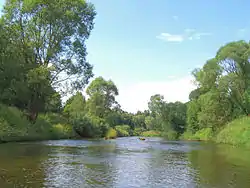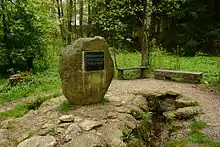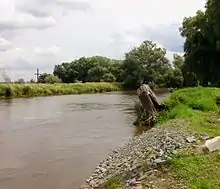Lusatian Neisse
The Lusatian Neisse[1][2][3] (German: Lausitzer Neiße; Polish: Nysa Łużycka; Czech: Lužická Nisa; Upper Sorbian: Łužiska Nysa; Lower Sorbian: Łužyska Nysa), or Western Neisse, is a 252-kilometre (157 mi) river in northern Central Europe.[4][5] It rises in the Jizera Mountains, near Nová Ves nad Nisou, at the Czech border becoming the Polish–German border for its remaining 197 kilometres (122 mi), to flow into the similarly northward-flowing Oder.
| Lusatian Neisse | |
|---|---|
 The Neisse near Skerbersdorf, Krauschwitz municipality | |
 Oder and Neisse rivers | |
| Location | |
| Countries | |
| Physical characteristics | |
| Source | Jizera Mountains |
| • location | Nová Ves nad Nisou, Liberec Region, Czech Republic |
| • coordinates | 50°43′47″N 15°13′44″E |
| • elevation | 655 m (2,149 ft) |
| Mouth | Oder |
• location | Neißemünde, Brandenburg, Germany |
• coordinates | 52°4′11″N 14°45′20″E |
• elevation | 32 m (105 ft) |
| Length | 252 km (157 mi) |
| Basin size | 4,403 km2 (1,700 sq mi) |
| Discharge | |
| • average | 31 m3/s (1,100 cu ft/s) |
| Basin features | |
| Progression | Oder→ Baltic Sea |



Its drainage basin covers 4,403 km2 (1,700 sq mi), of which 2,201 km2 (850 sq mi) is in Poland, the rest is mainly in Germany.[6] The river reaches the tripoint of the three nations by Zittau, a German town/city, after 54 kilometres (34 mi), leaving the Czech Republic.[6] It is a left-bank tributary of the Oder, into which it flows between Neißemünde-Ratzdorf and Kosarzyn – north of the towns of Guben and Gubin.
Since the 1945 Potsdam Agreement in the aftermath of World War II, the river has partially demarcated the German-Polish border (along the Oder–Neisse line). The German population east of the river was expelled from Poland to Germany.
It is the longest and most watered of the three rivers of its non-adjectival name in both the main languages (the two other rivers being the Eastern Neisse (Polish: Nysa Kłodzka; German: Glatzer Neisse) and Raging Neisse (Polish: Nysa Szalona; German: Wütende Neiße or Jauersche Neiße)). It is usually simply referred to as the Neisse.
Name
Since the river runs through the historic region of Lusatia, the adjective "Lusatian" or "Western" before the name of the river Neisse is used whenever differentiating this border river from the Eastern Neisse (Polish: Nysa Kłodzka, German: Glatzer Neisse) and the smaller Raging Neisse (Polish: Nysa Szalona; German: Wütende Neisse or Jauersche Neisse), both in Poland.
Towns and villages
At Bad Muskau the Neisse flows through Muskau Park, a UNESCO World Heritage Site. Cities and towns on the river from source to mouth include:
- Jablonec nad Nisou, Czech Republic
- Vratislavice, Czech Republic
- Liberec, Czech Republic
- Chrastava, Czech Republic
- Hrádek nad Nisou, Czech Republic
- Zittau, Germany
- Bogatynia, Poland
- Görlitz, Germany; Zgorzelec, Poland
- Pieńsk, Poland
- Bad Muskau, Germany; Łęknica, Poland
- Forst (Lausitz), Germany
- Guben, Germany; Gubin, Poland
References
- Tockner, Klement; Uehlinger, Urs and Robinson Christopher T. (2009). Rivers of Europe, Academic Press, London, Burlington and San Diego. ISBN 978-0-12-369449-2.
- Fritsch-Bournazel, Renata (1992). Europe and German Unification, Berg, Oxford and Providence, RI, p. 106. ISBN 0 85496 979 9
- McKenna, Amy (2014). Estonia, Latvia, Lithuania, and Poland, Britannica Guide to Countries of the EU, New York, p. 193. ISBN 978-1-61530-991-7.
- Neisse River at www.britannica.com. Retrieved 4 Feb 2011.
- Transnational Pilot River Basin at http://eagri.cz/public. Retrieved 4 Feb 2011.
- Statistical Yearbook of the Republic of Poland 2017, Statistics Poland, pp. 85–86
External links
- Bibliography on Water Resources and International Law Peace Palace Library
- Closed Germany–Poland bridges
